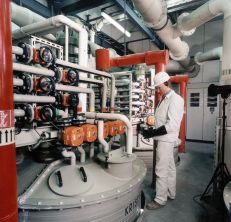the Tantalum-Niobium International Study Center (T.I.C.) : Processing: extraction and refining : About Tantalum
An international, non-profit association founded in 1974 under Belgian law.
- Metals: Tantalum (Ta)
- Read 852 Times
- Metals: Tantalum (Ta)
- Industries : ALL, Miners, Processing
Processing: extraction and refining

The extraction and refining of tantalum, including the separation from niobium in these various tantalum-containing mineral concentrates, is generally accomplished by treating the ores with a mixture of hydrofluoric and sulfuric acids at elevated temperatures. This causes the tantalum and niobium values to dissolve as complex fluorides, and numerous impurities that were present also dissolve. Other elements such as silicon, iron, manganese, titanium, zirconium, uranium, thorium, rare earths, et c. are generally present. The filtration of the digestion slurry, and further processing via solvent extraction using methyl isobutyl ketone (MIBK) or liquid ion exchange using an amine extractant in kerosene, produces highly purified solutions of tantalum and niobium. Generally, the tantalum values in solution are converted into potassium tantalum fluoride (K2TaF7) or tantalum oxide (Ta2O5). The niobium is recovered as niobium oxide (Nb2O5) via neutralization of the niobium fluoride complex with ammonia to form the hydroxide, followed by calcination to the oxide.
here exist alternative methods which are used when they are better suited to particular local conditions. One used for a titanium-niobium-tantalum-rare earth mineral concentrate involves blending the crushed concentrate with coke and passing this through a chlorination stage which separates out the rare earths and other elements including most of the thorium. The resulting titanium-niobium-tantalum oxichloride gas is dropped in temperature which causes the iron, thorium and alkali metals to precipitate out. The cleaned titanium-niobium-tantalum oxichloride gas is then cooled to a liquid and distilled to separate out low-boiling titanium chloride gas, whereafter the niobium-tantalum oxichloride gas is further chlorinated to produce NbCl5 and TaCl5. These chlorides are fractionally distilled and the niobium chloride subsequently reacted with steam to produce the hydroxide which is calcined to oxide. The tantalum chloride is reacted with ammonium hydroxide to produce the oxide.
The primary tantalum chemicals of industrial significance, in addition to K2TaF7 and Ta2O5, are tantalum chloride (TaCl5), lithium tantalate (LiTaO3) and tantalum carbide (TaC).
Tantalum metal powder, including the precursor to capacitor grade powder, is generally produced by the sodium reduction of the potassium tantalum fluoride in a molten salt system at high temperature. The metal can also be produced by the carbon or aluminium reduction of the oxide or the hydrogen or alkaline earth reduction of tantalum chloride. The choice of process is based on the specific application and whether the resultant tantalum will be further consolidated by processing into ingot, sheet, rod, tubing, wire and other fabricated articles.
The consolidation of metal powder for ingot and processing into various metallurgical products begins with either vacuum arc melting or electron beam melting of metal feedstocks, comprised of powder or high purity scrap where the elements with boiling points greater than tantalum are not present. Double and triple melt ingots achieve a very high level of purification with regard to metallics and interstitials. Ingots are used to produce the various metallurgical products named earlier. Ingot stock is also used for the production of such alloys as tantalum-10% tungsten. Ingot and pure tantalum scrap are used in the production of alloys for land and air-based turbines.
Primary or Secondary Processor?
In the tantalum industry distinction is often made between “primary processors” and “secondary processors”, the difference indicating where a company fits in the supply chain and consequently also which materials the company is likely to purchase and, to a lesser extent, which materials they might produce. The distinction is also of relevance to whether a company is considered a ‘smelter’ for the purposes of conflict mineral supply chain management: primary processors are the equivalent of ‘smelters’, whereas secondary processors are ‘downstream’ industry.
Primary processors are those which have the capability to process the primary raw materials, whether they be tantalum mineral concentrates or slags. A primary processor is generally also able to process secondary concentrates (columbite or struverite), synthetic concentrates and/or scrap. The products of a primary processor may be anything from the most common tantalum intermediate ‘K-salt’ (K2TaF7), through to high purity oxides or capacitor grade tantalum metal powder.
Secondary processors are those which can not handle minerals or slags, but instead take tantalum intermediates and further process them into final products. For example, a secondary processor may buy K-salt, metallurgical grade tantalum metal powder or tantalum ingot, then apply further chemical and/or metallurgical processing (e.g. reduction, or vacuum arc melting, or powder injection moulding) and produce final products such as oxides, capacitor grade powder, or metal products such as tubes or wire.
- Author: Tantalum-Niobium International Study Center (T.I.C.)
- Published Date: 10/03/2025
- The T.I.C. was established in response to concerns within the tantalum industry regarding the lack of useful information on tantalum source materials. The initial purpose of the T.I.C. was to spread information about tantalum and to promote the common interest and welfare of the producers, especially with public and private authorities, organisations and agencies. Since its foundation, the T.I.C. has grown to encompass niobium and all stages of the tantalum/niobium supply chains.
Advancing sustainability, technology, and industry collaboration since 1974.
Driving Global Innovation in Tantalum and Niobium
Connecting global innovators in tantalum and niobium, driving advancements from raw materials to cutting-edge applications.
- Supporting over 90 members across 30 countries.
- Promoting cutting-edge research and development.
- Facilitating a global network of professionals.
